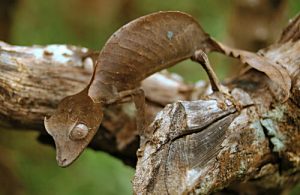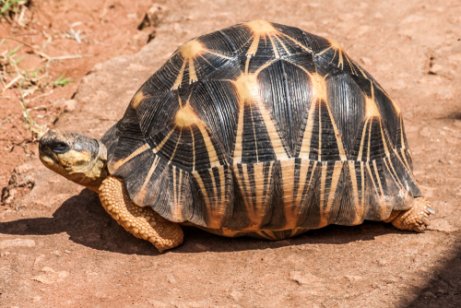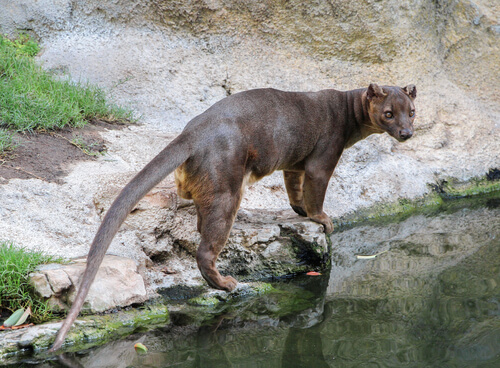The Impressive Wildlife of Madagascar

This African island is considered to be one of the most biodiverse countries in the world. The vast majority of the wildlife of Madagascar is endemic, which means that it does not live anywhere else in the world. So read this article to learn all about some of these species!
What makes up the wildlife of Madagascar?
Until the arrival of humans around 2,000 years ago, the island was inhabited by large animals, such as the hippopotamus, the aye-aye, and elephant birds, which were about 3 meters tall.
Deforestation, hunting, urban development, and tourism have led to the extinction of many species.
The good news is that there are currently more than 50 national parks and protected nature reserves, where you can observe several examples of the typical wildlife of Madagascar. Among them are the following:
1. Leaf-tailed Gecko
This is one of the animals on the island of Madagascar that has attracted the most attention because of the unique design of its body, especially its tail that’s shaped like a lear. This tail makes this gecko a master of camouflage.
This geck0 — shown in the image at the top of this article — is small, lives in tropical forests on the island, and is usually brown or greenish. However, these geckos have also been seen with yellow, orange, or purple coloring.
The gecko doesn’t have eyelids, so it uses its long tongue to clean dirt that could prevent it from being able to see.
2. Lemur
These primates are famous for their long black and white tails and bulging eyes. Lemurs are a nocturnal animal that can weigh up to nine kilos, and feed mainly on leaves and fruits. Sometimes, they do eat small insects.

Groups of these animals are socially dominated by females, which is a matriarchy. Each group is made up of about 15 individuals.
Their biological clock is based on the lunar phases and the time of year. For example, they are more active under a full moon.
In addition, they can go into a mild hibernation to reduce their body temperature and metabolism. Lemurs are the only primate with this type of behavior.
3. Radiated Tortoise
Know for its shell that appears to be covered with stars, this species is in critical condition of extinction. In addition to living in Madagascar, you can find a few of these specimens on the Mauritius Islands. The tortoise has been introduced there by man. This animal prefers arid, dry regions with forest areas.

The radiated tortoise is known for its shell. The shell is primarily dark brown and has yellow circles and lines, which appear in the shape of stars. It is also a large animal. Males can reach up to 20 kilos. They also live a very long time, almost 100 years.
4. Giant Chameleon
This scaled sauropsid is the largest chameleon in the animal kingdom that can measure almost up to 70 centimeters long. These animals have become the representatives of the wildlife of Madagascar. Their bodies are green and brown. They have a curved crest on their heads, which is larger in males.

Like other chameleons, this animal also can move its eyes separately, spread their fingers and toes, and quickly stretch out its long tongue. They grab on to tree trunks with their claws and tail.
The giant chameleon of Madagascar is found in the forest. They feed on birds, insects, and small mammals. Their lifespan is about 10 years. They reach sexual maturity at one year and their pregnancy lasts for 40 days.
5. Fossa
This is the largest mammal on the island. Its diet is mainly based on eating lemurs. Its appearance is a combination of several carnivores: the body of a cougar, the eyes of a bear, legs similar to a cat, and a dog-like snout. These animals can be up to 80 centimeters and their tails are longer than their torsos.

Fossas have dark brown or reddish, short fur. They have retractable claws, short muscular legs, and long bodies. They can jump from tree to tree. When walking on the ground, they support themselves just on the soles of their feet.
Fossas are nocturnal and solitary animals and they mark their territory through powerful secretions.
Fossas are considered to be demonic animals in Madagascar due to many legends that revolve around them. In rural areas, they are accused of killing ducks, chicken, and pigs, which has caused a decline in the population in recent years. However, it is a fairly docile and even an affectionate animal in captivity.
This African island is considered to be one of the most biodiverse countries in the world. The vast majority of the wildlife of Madagascar is endemic, which means that it does not live anywhere else in the world. So read this article to learn all about some of these species!
What makes up the wildlife of Madagascar?
Until the arrival of humans around 2,000 years ago, the island was inhabited by large animals, such as the hippopotamus, the aye-aye, and elephant birds, which were about 3 meters tall.
Deforestation, hunting, urban development, and tourism have led to the extinction of many species.
The good news is that there are currently more than 50 national parks and protected nature reserves, where you can observe several examples of the typical wildlife of Madagascar. Among them are the following:
1. Leaf-tailed Gecko
This is one of the animals on the island of Madagascar that has attracted the most attention because of the unique design of its body, especially its tail that’s shaped like a lear. This tail makes this gecko a master of camouflage.
This geck0 — shown in the image at the top of this article — is small, lives in tropical forests on the island, and is usually brown or greenish. However, these geckos have also been seen with yellow, orange, or purple coloring.
The gecko doesn’t have eyelids, so it uses its long tongue to clean dirt that could prevent it from being able to see.
2. Lemur
These primates are famous for their long black and white tails and bulging eyes. Lemurs are a nocturnal animal that can weigh up to nine kilos, and feed mainly on leaves and fruits. Sometimes, they do eat small insects.

Groups of these animals are socially dominated by females, which is a matriarchy. Each group is made up of about 15 individuals.
Their biological clock is based on the lunar phases and the time of year. For example, they are more active under a full moon.
In addition, they can go into a mild hibernation to reduce their body temperature and metabolism. Lemurs are the only primate with this type of behavior.
3. Radiated Tortoise
Know for its shell that appears to be covered with stars, this species is in critical condition of extinction. In addition to living in Madagascar, you can find a few of these specimens on the Mauritius Islands. The tortoise has been introduced there by man. This animal prefers arid, dry regions with forest areas.

The radiated tortoise is known for its shell. The shell is primarily dark brown and has yellow circles and lines, which appear in the shape of stars. It is also a large animal. Males can reach up to 20 kilos. They also live a very long time, almost 100 years.
4. Giant Chameleon
This scaled sauropsid is the largest chameleon in the animal kingdom that can measure almost up to 70 centimeters long. These animals have become the representatives of the wildlife of Madagascar. Their bodies are green and brown. They have a curved crest on their heads, which is larger in males.

Like other chameleons, this animal also can move its eyes separately, spread their fingers and toes, and quickly stretch out its long tongue. They grab on to tree trunks with their claws and tail.
The giant chameleon of Madagascar is found in the forest. They feed on birds, insects, and small mammals. Their lifespan is about 10 years. They reach sexual maturity at one year and their pregnancy lasts for 40 days.
5. Fossa
This is the largest mammal on the island. Its diet is mainly based on eating lemurs. Its appearance is a combination of several carnivores: the body of a cougar, the eyes of a bear, legs similar to a cat, and a dog-like snout. These animals can be up to 80 centimeters and their tails are longer than their torsos.

Fossas have dark brown or reddish, short fur. They have retractable claws, short muscular legs, and long bodies. They can jump from tree to tree. When walking on the ground, they support themselves just on the soles of their feet.
Fossas are nocturnal and solitary animals and they mark their territory through powerful secretions.
Fossas are considered to be demonic animals in Madagascar due to many legends that revolve around them. In rural areas, they are accused of killing ducks, chicken, and pigs, which has caused a decline in the population in recent years. However, it is a fairly docile and even an affectionate animal in captivity.
This text is provided for informational purposes only and does not replace consultation with a professional. If in doubt, consult your specialist.








